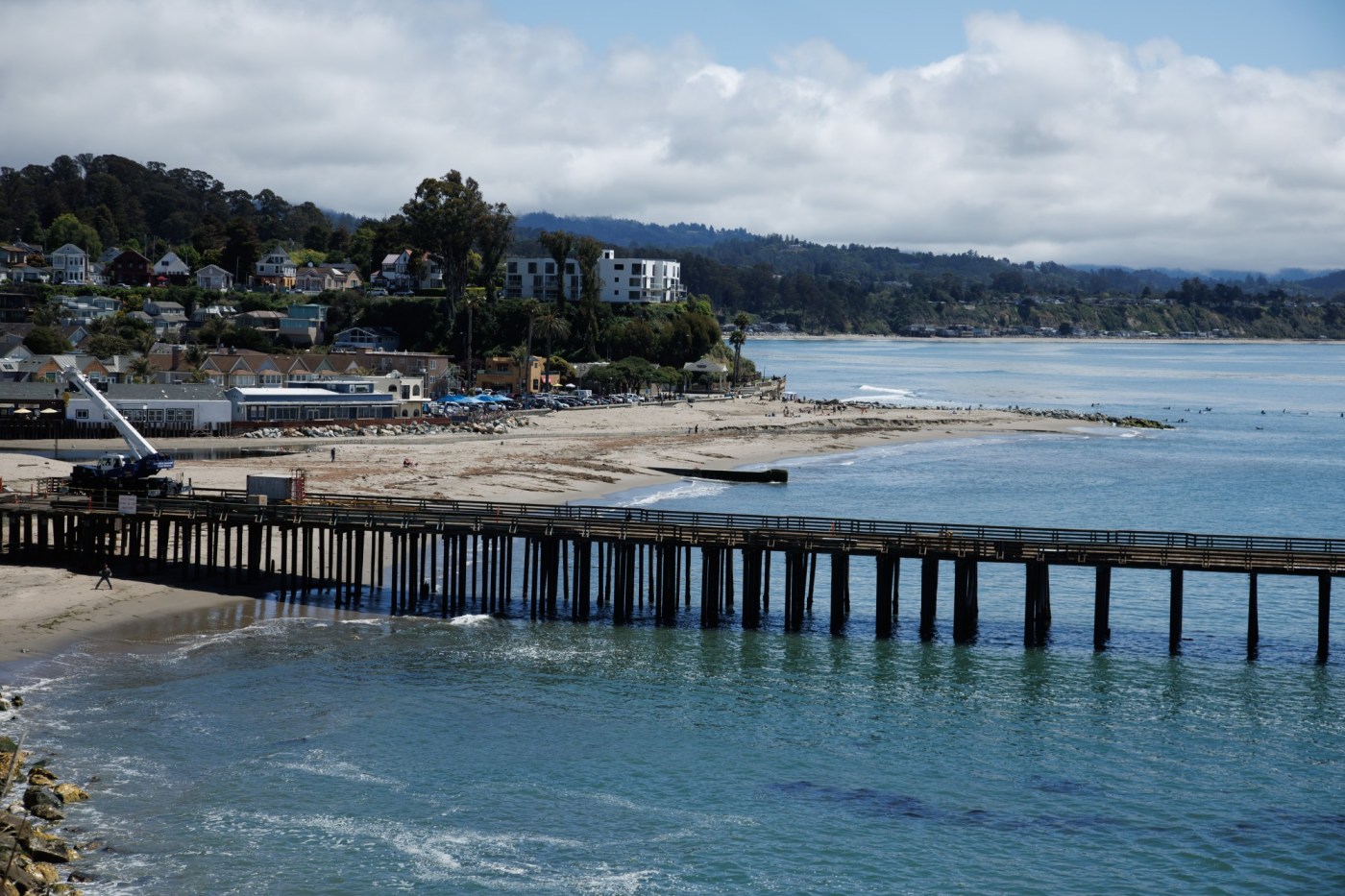The storm-broken wharf in Capitola has risen again, with local dignitaries celebrating its $10 million renewal at a “grand reopening” Wednesday on the structure that juts out from the colorful coastal-tourism mecca.
Hundreds of locals and tourists packed the end of the 855-foot pier as tiny wavelets lapped the shore under bright blue skies — a far cry from the giant pounding waves and torrential rain of the cataclysm that ushered in 2023 by wrecking the wharf and causing widespread damage and flooding up and down the coast.
The structure received heavy damage in the first week of January last year when an unusually high tide combined with a massive storm and ocean swell to batter the end of the wharf and tear apart a section of the middle, causing about $1 million in damage and costing another $800,000 to remove a restaurant and bait shop ruined by the breaking waves. The extent of the damage and the importance of Capitola as a premier tourist destination drew President Joe Biden and Gov. Gavin Newsom to survey the scene and promise help.
The renewal project involved replacing more than 100 of the vertical wooden support piles, some of them more than 50 years old. The new piles, of fiberglass filled with sand, are expected to be more durable. All the wood decking and railings have been replaced.
“It’s really iconic Capitola,” the city’s public works director Jessica Kahn said of the wharf. “Many generations of people learned how to fish out here. Locals take morning strolls. It’s super popular for tourists.”
Dan Soden, of Capitola, who often fished from the wharf as a child, was celebrating its reopening by fishing for halibut. “I’m just really pleased that we actually have this back,” said Soden, 62, a retired public works inspector. “I went through withdrawals after it fell.”
Peggy Piedade and her husband, Mike, visiting from Discovery Bay in eastern Contra Costa County, said they had not been on the wharf for years and had heard it had been destroyed. The timing of their trip, coinciding with the wharf’s reopening, was “perfect,” said Peggy, 73, a retired nurse. “The water is just amazing.”
At the end of the wharf Wednesday afternoon, State Sen. John Laird, D-Santa Cruz, said Capitola’s notoriety helped him get $500,000 for the wharf renewal into the state budget after the early-2023 storm.
An $8 million state and federally funded project to strengthen the wharf, first built in 1857 before Abraham Lincoln became president, had already been underway when the early-2023 storm hit. Steel support piles at the end of the wharf had been replaced.
“We were really lucky that we had done some of that work,” Kahn said. “It probably saved the head of the wharf from collapsing.”
A year after that storm, another one hit, further damaging the restaurant and bait shop and tearing up some of the reconstructed portion in the middle. “We had to redo some of the work we had already done,” Kahn said.
Previously, the wharf was 20 feet wide for most of its length and 40 feet across at the end. Now it’s 40 feet wide throughout. A new public restroom facility with three units replaces the old one that was in the restaurant building and hard to find, Kahn said.
Today, a new entrance gateway created by local artist Kathleen Crocetti welcomes visitors with mosaics of kelp and sea urchins. The bait shop, with snacks, drinks and souvenirs, is back, but in a temporary structure. A local fundraising drive netted $425,000, which paid for the gateway, benches, trash cans and free binocular viewers for visitors.
Whether another restaurant goes up remains to be seen. Kahn said she expects “solid direction” from Capitola’s City Council in about six months. Food trucks are another option, she added.
But no matter how well the wharf has been rebuilt, history and a heating climate suggest the structure will not escape future storms unscathed, said Gary Griggs, earth sciences professor at UC Santa Cruz and author of the book Between Paradise and Peril: The Natural Disaster History of the Monterey Bay Region.
The wharf pokes into Monterey Bay in the same location it’s been since the first one was built — and lasted less than a decade before a storm ravaged much of it. Subsequent iterations of the structure have suffered significant damage about nine times.
“Time and time again, the waves smack into it,” Griggs said.
The direction of the swell plays a key role in risk to the Capitola Wharf, Griggs said. Most of the time, the swell comes from the northwest, and the structure is sheltered by the contours of the coast. But when the waves come from the west and southwest, as they did in early 2023, they hit the westward-facing wharf directly. In that storm, an offshore buoy recorded a swell 28 feet high — “about as big as it gets here” — and the waves both smashed into the wharf and surged into it from beneath, Griggs said.
Still, the extremely high tide peaking as the waves were at their biggest created a double-whammy on a scale not seen in Capitola for three decades, Griggs noted.
However, climate change is causing a gradual rise in sea level, and studies indicate that as the ocean warms, putting more energy into it, waves are getting bigger.
“There’s nothing we can do to stop the Pacific Ocean,” Griggs said. “It’s a question of how much damage we’re willing to take.”












